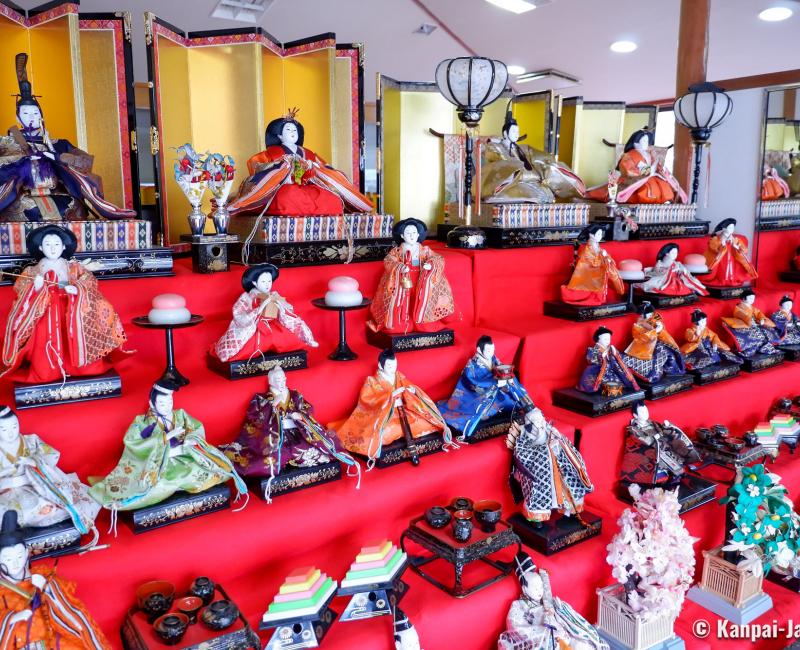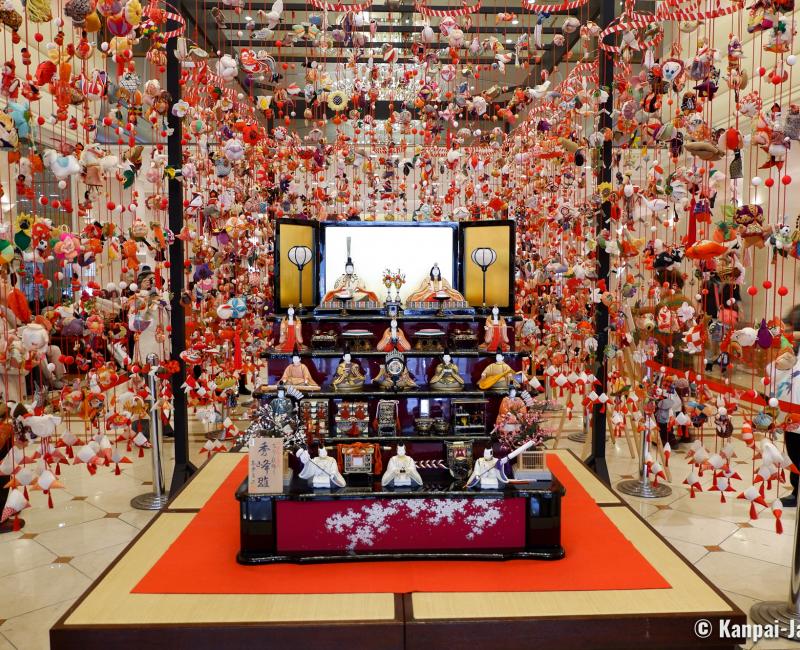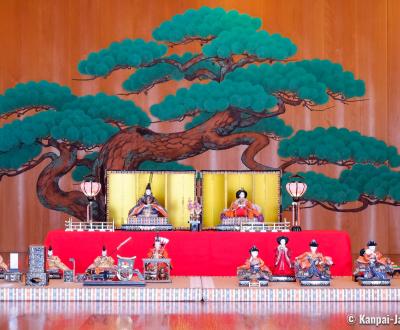Hina Matsuri
🎎 The Celebration of Girls and Spring in Japan
Hina Matsuri is a traditional Japanese festival celebrated on March 3 by families who have at least one daughter, regardless of their age. It is also called the "dolls festival" or "girls’ day." Originally a ritual to pray for all the household’s children good health and prosperity, it has become a harbinger of spring.
Hina Matsuri 🎎 is also called "peach blossom festival" (桃の節句 momo no sekku), as the peach tree is renowned for its ability to ward off demons, and its fruit is a longevity symbol. The date of the celebration corresponds to the beginning of the peach trees blooming, from late February for the earliest.
March 3 is one of the 5 sekku (節句) celebrations that mark the passing of seasons, with:
- January 1 (New Year),
- May 5 (Kodomo no hi or Children’s day),
- July 7 (Tanabata 🎋 or Star festival), and,
- September 9 (Kiku no sekku or Chrysanthemum Festival).
These dates, with the same odd number for day and month, were considered propitious days highlighted by celebrations and the enjoying of typical dishes.
During Heian period when the celebration started to develop, the word hina (ひな, also pronounced hiina ひいな) was used for small dolls made of paper, clay or wood with which little girls played. Back in the days, "Playing dolls" (hiina asobi ひいな遊び) was one of little girls’ favorite plays, like today. Seasoned linguists may have spotted that hina is frequently written with the character雛, which means "chick" or "hatchling" and is homophonous to hina meaning "doll." Associated with another character, it adds the meaning of "cute and small." With the popularization of the spring celebration and the use of human image for this, the festival became the "cute dolls" (hina ningyo ひな人形 or 雛人形) festival.
What are the origins of Hina Matsuri?
Nowadays, the dolls’ festival consists in exhibiting precious ornamental dolls on a several tiers display rack or hina dan (ひな壇), covered with a red cloth (dankake 段掛) and decorated with branches of peach trees, cherry trees 🌸 or tachibana orange trees. The current form of Hina Matsuri dates back to Edo period (1603-1868). This festival and the dolls were initially celebrated in the Imperial court and among the nobility, then from the 18th century, the tradition spread all over Japan, first in the warrior class’ families, then to the rest of the people.
Several roots, sometimes intertwined, to this tradition can be traced:
- The origin of the celebration is said to date back to Heian period (794-1185). At the time, human-shaped figurines were thought able to attract human’s infortune and impurities, thus used during Shinto rituals. Members of the Imperial Court offered dolls to the Imperial Family, especially little girl dolls to the princesses, so they protect them from the infortune and impurities that may have befallen the daughters of royalty.
- Another explanation of Hina Matsuri’s origins is an ancient custom of Kyoto: Nagashi bina (流し雛) or "floatting dolls." Straw dolls were placed on a little boats released into a river. Thus, the miniature ships sailed to the sea to take away bad spirits and misfortune. In these purification rituals, the dolls were worshipped for their protective proprieties.
- It might also be the association of a purification ritual using human-shaped (hinagata ひな形) sheets of paper and the tradition to gift dolls to children. Later, it became a celebration to wish happiness to the girls.
A celebration with many evolutions
The date of this celebration was modified during Meiji era (1868-1912) when Japan officially adopted the Gregorian calendar. In the lunar calendar used until Edo period, the celebration was due on the third day of the third month, or Hina Matsuri in early April according to our current calendar. The influence of the lunar calendar is still visible in some northern regions of Japan, including Tohoku and Hokuriku, were Hina Matsuri tends to be celebrated on April 3. In these cold and snowy areas, spring comes in later, so a date in April makes sense considering their reality.
During Edo period, Hina Matsuri was strongly connected to Kiku no sekku, the Chrysanthemum Festival, on the ninth day of the ninth month, when dolls were displayed again. The chrysanthemum flower is the symbol of the Imperial Family, but also of the sun and longevity. This date is rarely celebrated nowadays.
The habit to precisely recreate Heian court’s costumes for the dolls also appeared during the second half of Edo period. It was the premises of the kokinbina (古今雛 "timeless dolls") dolls made in Edo during the eponymous period and with characteristic features.
Hina Matsuri’s decorations were part of the girls’ dowry, and the number of dolls and their accessories were statements of the family’s wealth.

What are the characteristics of today's Hina Matsuri?
From a practice originating in the nobility, the celebration has widely spread in the population. Families exhibit dolls representing the emperor and the empress, respectively O Dairisama (お内裏様) and O hinasama (お雛様), as well as members of the imperial court, court ladies, musicians, etc. in a conventional arrangement that can vary depending on the areas of Japan. From the end of the 18th century to the Bakumatsu (1853 – 1868), the number of dolls displayed gradually increased, with the addition of rows for kanjo (官女), zuishin (随身), and shicho (仕丁). However, the imperial couple is always on the top and in the center of the display. Its presence only can also symbolize the whole set of dolls.
The whole set including the dolls, the several tiered platform and the accessories is called hina kazari (雛飾り). The followong is one of the most common type of display:
- The imperial couple, with the emperor and the empress. The pair is named dairibina (内裏雛 "dolls of the palace"). They are placed side by side at the top of the platform, each on its own colored tatami ungenberi (繧繝縁), reserved for members of the Imperial Family. The emperor doll wears a sokutai (束帯) ceremonial cloth and a hat named kanmuri (冠), it holds a shaku (笏) scepter and has a short sword tachi (太刀). The empress doll is holding a fan and wears the "12 layers cloth" junihitoe (十二単). Its hair is adorned with several ornamental combs hirabitai (平額) and saishi (釵子).
- San nin kanjo (三人官女), the "three Court Ladies," on the second row, symbolize the women in service at the Palace. From left to right, their attributes are: a metal sake jug, a tray and a metal saddle to pour sake. The seated doll in the center is of a higher hierarchical rank than the two siding dolls.
- Go nin bayashi (五人囃子), the "five Musicians," on the third step, are Nô theater’s musicians, displayed with their instruments: the narrator utai (謡) is characterized by a fan, and accompanied by a flutist and three Japanese drum players.
- Zuijin ou Zuishin (随身), on the fourth row, are the emperor’s bodyguards. One doll is an old man, the other a young one, and they both are armed with bow and arrows.
- Shicho (仕丁), the "palace civil servants" (sometimes warriors) are three small dolls on the fifth row. In Kanto area, they hold umbrellas and sunshades to protect the emperor from the weather, as well as a tray with food. In Kansai area, they rather carry cleaning tools: brooms, dustpans and rakes that are the symbol of their duty to clean the palace. They embody three emotions: anger, sadness and joy.
The appearance of the dolls, their hair and attire can greatly vary according to the regions, the manufacturers, and even to the tastes or fashions. Generally, the imperial couple is placed at the center of the arrangement and highlighted by miniature folding screens and decorative items that symbolize the Court’s magnificence. The lowest rows of the display can be used to place ritual offerings and accessories for the dolls: miniature mirrors, miniature jubako (refined bento 🍱 box), or items for the tea ceremony.
These ornamental dolls are very expensive, as they are made of refined and precious materials (China, silk, etc.), and therefore generally constitute a legacy kept within the family. A new doll is also quite frequently offered to a newborn girl, to enlarge the collection. However, due to the cost and the lack of conservation space, many families settle for keeping and exhibiting only the imperial couple, or even only the empress doll. An average collection usually includes about fifteen dolls.
Without traditional ornamental dolls, the imperial couple can be symbolized by kokeshi dolls or origami folded dolls. In some regions, the ritual of nagashi bina is continued, and dolls on a wicker flat basket are set adrift into a river.
How to celebrate Hina Matsuri today?
The celebration starts with decorating the house with the hina dan display and the dolls a few days before the date. On March 3, peach tree branches and offerings are added to the decorations. On this day, children are gathered and the family feasts with traditional dishes. Little girls are clad in long-sleeves kimono 👘 and go to the shrine with family to pray and receive presents.
In Japan, there are specific dishes for every celebration, and the food served for Hina Matsuri is called hina ryori (雛料理). It is a set of seasonal dishes that can also be purchased in department stores. They are also used as traditional offerings on March 3 and placed on the lower tiers of the hina dan. These specialties are:
- Hishi mochi (菱餅), a cake made from glutinous rice and shaped as a diamond. The three colored layers symbolize the beginning of the spring: white for the snow or the mist, green for the buds and red (or pink) for peach flowers.
- Hina arare (雛あられ), in Kanto area it is the name of sweet rice crackers, and in Kansai area they are bite-size sweet and savory or salted mochi. The colors pink, green, yellow and white are meant to symbolize the seasons.
- Chirashi zushi (ちらし寿司), a rice dish garnished with various sorts of raw fish, vegetables, with rapeseed branches and leaves dressed with soy sauce, and clear soups garnished with various types of clams.
- Lastly, a cup of sweet sake shirozake (白酒) is offered to the guests.
Dolls are displayed from several days before the celebration, but they are usually removed immediately at the end of the day, so as to not jeopardize the girls’ future marriage. The legend of the risk of a late wedding developed in the beginning of Showa era (1926-1989), but considering the former lunar calendar, the custom to quickly put away the dolls may have aimed at protecting them from damages by insects and mold during the rainy season tsuyu ☔️ (梅雨) at the beginning of spring.
Nowadays, the celebration of Hina Matsuri tends to recede. It is especially dedicated to girls and is the counterpart to the children’s day on May 5, directed toward boys.

Where to see Hina dolls in Japan?
When traveling in Japan between late February and March 3, it is possible to admire these wonderful dolls in many places. The most important are:
- Shimogamo shrine in Kyoto, where the nagashi bina tradition is perpetuated: dolls are set adrift on small boats on rivers Takano and Kamo to pray for the children’s health.
- The luxurious Hotel 🏨 Gajoen Tokyo in Meguro opens to the public, especially for Hina Matsuri and the few days before, its seven richly ornamented rooms in its oldest part, the Hyakudan Kaidan (the "100-step stairway"), and where an impressive collection of ancient dolls are on display for the Hyakudan Hina-Matsuri. Admission is paid.
- Tomisaki-jinja shrine in Katsuura city in Chiba prefecture, is a bit remote but very popular, and offers a spectacular Hina Matsuri called Katsuura Big Hina Matsuri (かつうらビッグひなまつり) since 2001. One of its stairways is used as a giant hina dan, named for the occasion Tomisaki Ishidan (富咲石段) "the steps of flourishing prosperity," in a pun on the shrine’s name Tomisaki (遠見岬) "the cape of the farther view." The 60 steps receive 1,800 dolls, highlighted in the evening with a specific lighting. About 400,000 persons visit the shrine for this occasion each year.
- Awashima-jinja shrine in Kada city, Wakayama prefecture, a little bit off the beaten tracks, is a high place for nagashi bina. On March 3, women and girls of the area, but also from all over Japan, gather to attend to a ceremony starting at noon. It consists in writing a wish on a doll that will be placed on a white wood bark. Hundreds of barks are then released to sea and participants will see them off while praying until they disappear from view with their messages to the gods.
- In Kyushu Island, the celebration of Hina Matsuri starts as soon as January and last until April. Yanagawa city, in Fukuoka prefecture, is renowned for its canals but also for the tradition of Sagemon, the creation of small items from scrap fabric, hanged in the house for girls’ first Hina Matsuri. The whole city is decorated with thousands of figures garlands hanging, creating a fairy atmosphere from February to April.
The dolls are also viewable in many public places, train 🚅 stations and shopping malls, throughout the country during February and March. Some upscale hotels, like the Keio Plaza Tokyo in Shinjuku (see pictures below) open their lobbies to dolls exhibitions accessible to anyone.
Lastly, Iwatsuki ward in Saitama city, in the north of Tokyo, is renowned as the birthplace of these dolls’ making, and is even nicknamed "dolls’ town," notably for its 50 specialized shops. The city is also home to Iwatsuki dolls’ museum (Iwatsuki ningyo museum) displaying an important collection of Hina Matsuri dolls and their fabrication methods. In Tokyo, the specialized area is Asakusabashi, near Akihabara. The most famous manufacturers, including Ningyo-no-Kyugetsu, Yoshitoku and Togyoku have their shops there. Traditional dolls are of course also available from department stores.

